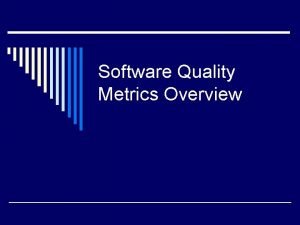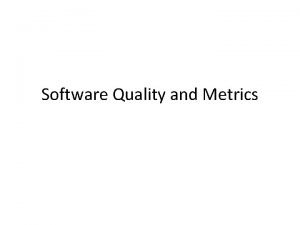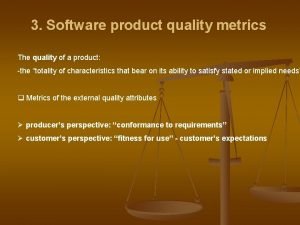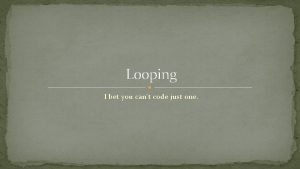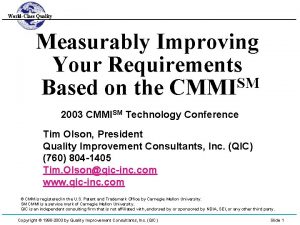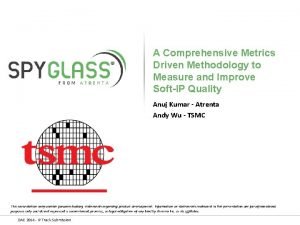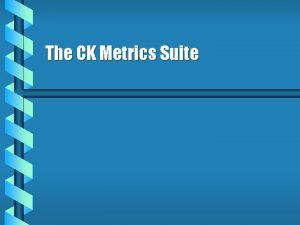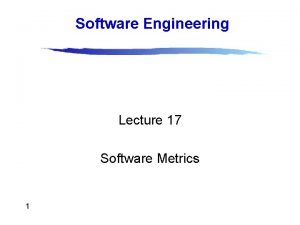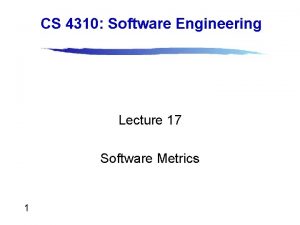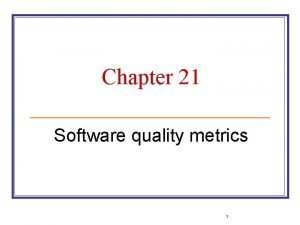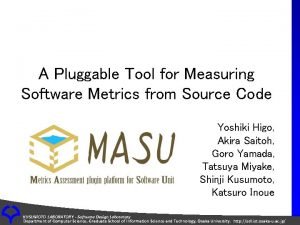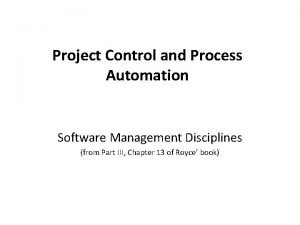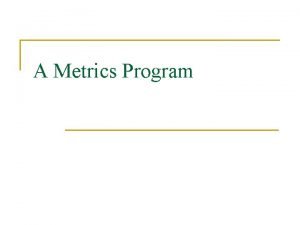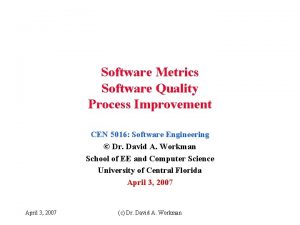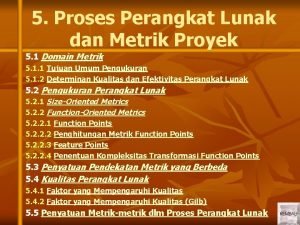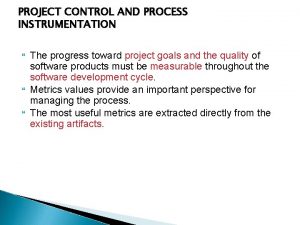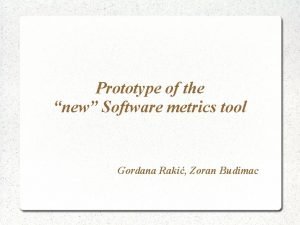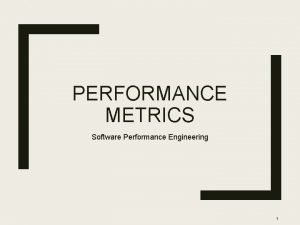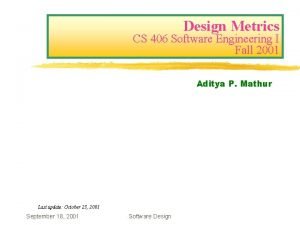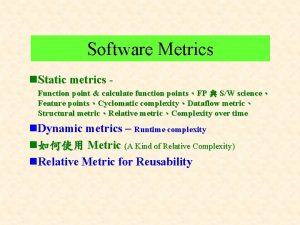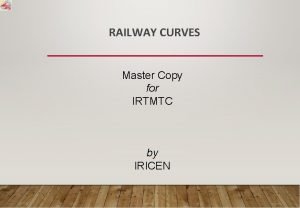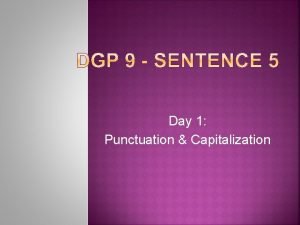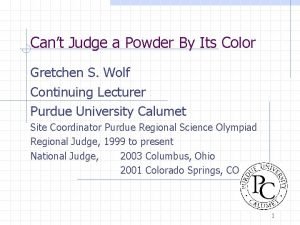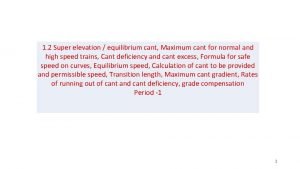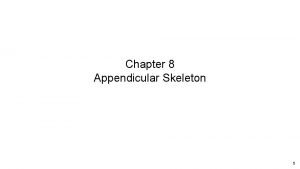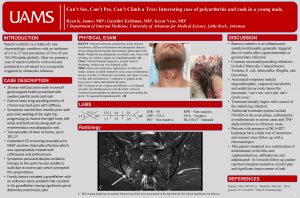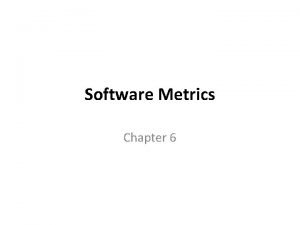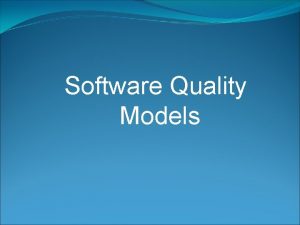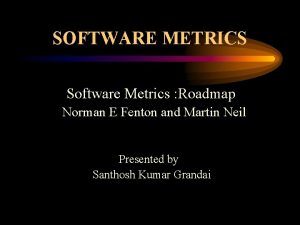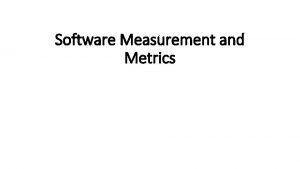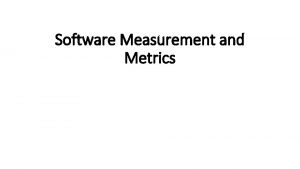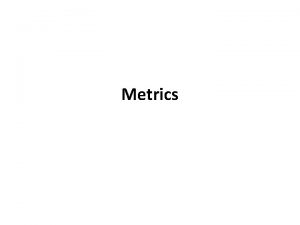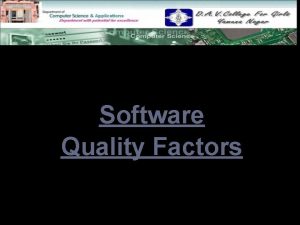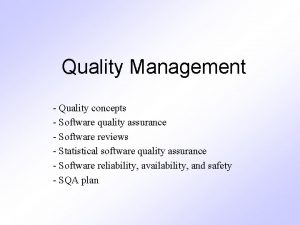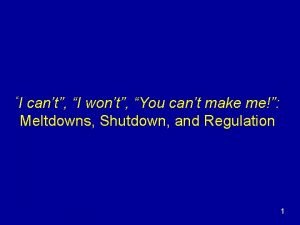Chapter 21 Software quality metrics 1 You cant














































- Slides: 46

Chapter 21 Software quality metrics 1

“You can’t control what you can’t measure” Tom De. Marco Software Quality metrics as tool for QA tools 2

Measurement, Measures, Metrics Measurement ◦ Measure ◦ is the act of obtaining a measure provides a quantitative indication of the size of some product or process attribute, E. g. , Number of errors Metric ◦ is a quantitative measure of the degree to which a system, component, or process possesses a given attribute (IEEE Software Engineering Standards 1993) : Software Quality - E. g. , Number of errors found person hours expended 3

IEEE definitions of software quality metrics (1) A quantitative measure of the degree to which an item possesses a given quality attribute. (2) A function whose inputs are software data and whose output is a single numerical value that can be interpreted as the degree to which the software possesses a given quality attribute. 4

Objectives of quality measurement 1. Facilitate management control, planning and managerial intervention. Based on: · Deviations of actual from planned performance. · Deviations of actual timetable and budget performance from planned. 2. Identify situations for development or maintenance process improvement (preventive or corrective actions). Based on: · Accumulation of metrics information regarding the performance of teams, units, etc. 5

Software quality metrics — Requirements General requirements n n n Relevant Valid Reliable Comprehensive Mutually exclusive Operative requirements n n n Easy and simple Does not require independent data collection Immune to biased interventions by interested parties 6

What to measure • • • Process Measure the efficacy of processes. What works, what doesn't. Project Assess the status of projects. Track risk. Identify problem areas. Adjust work flow. Product Measure predefined product attributes (generally related to ISO 9126 Software Characteristics) 7

Classification of software quality metrics Three kinds of Software Quality Metrics ◦ Product Metrics - describe the characteristics of product ◦ Process Metrics - used for improving software development/maintenance process ◦ size, complexity, design features, performance, and quality level effectiveness of defect removal, pattern of testing defect arrival, and response time of fixes Project Metrics - describe the project characteristics and execution number of developers, cost, schedule, productivity, etc. fairly straight forward 8

Software size (volume) measures KLOC — classic metric that measures the size of software by thousands of code lines. n Number of function points (NFP) — a measure of the development resources (human resources) required to develop a program, based on the functionality specified for the software system n 9

Process metrics n S/W development process metrics fall into one of the following categories: 1 -Software process quality metrics n n n Error density metrics Error severity metrics Error removal effectiveness metrics 2 - Software process timetable metrics 3 - Software process productivity metrics 10

Software process quality metrics n Software process quality metrics may be classified into two classes: n n n Error density metrics Error severity metrics Error removal effectiveness metrics 11

Error density metrics Calculation of error density metrics involves two measures: 1 - Software volume measures. Some density metrics use the number of lines of code while others apply function points. 2 - Errors counted measures. Some relate to the number of errors(NCE) and others to the weighted number of errors (WCE). n this measure is classification of the detected errors into severity classes, followed by weighting each class. n 12

Example n n A software development department applies two alternative measures, NCE and WCE, to the code errors detected in its software development projects. Three classes of error severity and their relative weights are also defined: there were 42 low severity errors, 17 medium severity errors, and 11 high severity errors 13

Calculation of NCE and WCE 14

Code Name CED Code Error Density DED Development Error Density WCED Weighted Code Error Density WDED Weighted Development Error Density WCEF Weighted Code Errors per Function Point WDEF Weighted Development Errors per Function Point Calculation formula NCE CED = ----- KLOC NDE DED = ----- KLOC WCE WCDE = ---- KLOC WDED = ---- KLOC WCEF = ----- NFP WDEF = ----- NFP NCE = The number of code errors detected by code inspections and testing. NDE = total number of development (design and code) errors) detected in the development process. WCE = weighted total code errors detected by code inspections and testing. WDE = total weighted development (design and code) errors detected in development process.

Calculation Of CED and WCED Example • The unit determined the following indicators for unacceptable software quality: CED > 2 and WCED > 4. • The software system size is 40 KLOC. Calculation of the two metrics resulted in the following:

Error severity metrics The metrics belonging to this group are used to detect adverse situations of increasing numbers of severe errors in situations where errors and weighted errors, as measured by error density metrics, are generally decreasing. n Two error severity metrics are presented as follows: n

Code Name ASCE Average Severity of Code Errors ASDE Average Severity of Development Errors Calculation formula WCE ASCE = ----- NCE WDE ASDE = ----- NDE NCE = The number of code errors detected by code inspections and testing. NDE = total number of development (design and code) errors detected in the development process. WCE = weighted total code errors detected by code inspections and testing. WDE = total weighted development (design and code) errors detected in development process.

Error removal effectiveness metrics • Software developers can measure the effectiveness of error removal by the software quality assurance system after a period of regular operation (usually 6 or 12 months) of the system. • The metrics combine the error records of the development stage with the failures records compiled during the first year (or any defined period) of regular operation. Two error removal effectiveness metrics are as follows.

Code Name Calculation formula NDE Development Errors Removal DERE = --------DERE Effectiveness NDE + NYF WDE DWERE Development Weighted DWERE = ---------Errors Removal Effectiveness WDE+WYF NDE = total number of development (design and code) errors) detected in the development process. WCE = weighted total code errors detected by code inspections and testing. WDE = total weighted development (design and code) errors detected in development process. NYF = number software failures detected during a year of maintenance service. WYF = weighted number of software failures detected during a year of maintenance service.

Software process timetable metrics • Software process timetable metrics may be based on accounts of success (completion of milestones per schedule) in addition to failure events (non-completion per schedule). • An alternative approach calculates the average delay in completion of milestones • TTO and ADMC metrics are based on data for all relevant milestones scheduled in the project plan. In other words, only milestones that were designated for completion in the project plan stage are considered in the metrics’ computation. Therefore, these metrics can be applied throughout development and need not wait for the project’s completion.

Code TTO Name Time Table Observance ADMC Average Delay of Milestone Completion Calculation formula MSOT TTO = ----- MS TCDAM ADMC = ----- MS MSOT = Milestones completed on time. MS = Total number of milestones. TCDAM = Total Completion Delays (days, weeks, etc. ) for all milestones.

Software process productivity metrics This group of metrics includes “direct” metrics that deal with a project’s human resources productivity as well as “indirect” metrics that focus on the extent of software reuse. n Software reuse substantially affects productivity and effectiveness. n

Code Name Dev. P Development Productivity FDev. P Function point Development Productivity CRe Code Reuse Doc. Re Documentation Reuse Calculation formula Dev. H Dev. P = -----KLOC Dev. H FDev. P = -----NFP Re. KLOC Cre = -------KLOC Re. Doc. Re = -----NDoc Dev. H = Total working hours invested in the development of the software system. Re. KLOC = Number of thousands of reused lines of code. Re. Doc = Number of reused pages of documentation. NDoc = Number of pages of documentation.

Product metrics refer to the software system’s operational phase – years of regular use of the software system by customers, whether “internal” or “external” customers, n In most cases, the software developer is required to provide customer service during the software’s operational phase. Customer services are of two main types: 1 -Help desk services (HD) – software support by instructing n customers regarding the method of application of the software and solution of customer implementation problems. 2 - Corrective maintenance services – correction of software failures identified by customers/users or detected by the customer service team prior to their discovery by customers. The number of software failures and their density are directly related to software development quality.

Product metrics n n HD metrics are based on all customer calls while corrective maintenance metrics are based on failure reports. Product metrics generally rely on performance records compiled during one year (or any other specified period of time). This policy enables comparisons of successive years in addition to comparisons between different units and software systems. The array of software product metrics presented here is classified as follows: ■ HD quality metrics ■ HD productivity and effectiveness metrics ■ Corrective maintenance quality metrics ■ Corrective maintenance productivity and effectiveness metrics. n

Product metrics It should be remembered that software maintenance activities include: ■ Corrective maintenance – correction of software failures detected during regular operation of the software. ■ Adaptive maintenance – adaptation of existing software to new customers or new requirements. ■ Functional improvement maintenance – addition of new functions to the existing software, improvement of reliability, etc. n In the metrics presented here we limit our selection to those that deal with corrective maintenance. For other components of software maintenance, the metrics suggested for the software development process (process metrics) can be used as is or with minor adaptations. n

HD quality metrics The types of HD quality metrics discussed here deal with: ■ HD calls density metrics – the extent of customer requests for HD services as measured by the number of calls. ■ Metrics of the severity of the HD issues raised. ■ HD success metrics – the level of success in responding to these calls. A success is achieved by completing the required service within the time determined in the service contract. n

HD calls density metrics n n For the HD call density there are six different types of metrics. Some relate to the number of the errors and others to a weighted number of errors. As for size/volume measures of the software, some use number of lines of code while others apply function points. The sources of data for these and the other metrics in this group are HD reports. Three HD calls density metrics for HD performance are presented as follows:

Code Name HDD HD calls density WHDD Weighted HD calls density WHDF Weighted HD calls per function point Calculation Formula NHYC HDD = -------KLMC WHYC = ------KLMC WHYC WHDF = ------NMFP NHYC = the number of HD calls during a year of service. KLMC = Thousands of lines of maintained software code. WHYC = weighted HD calls received during one year of service. NMFP = number of function points to be maintained.

Severity of HD calls metrics n n n The metrics belonging to this group of measures aim at detecting one type of adverse situation: increasingly severe HD calls. The computed results may contribute to improvements in all or parts of the user interface (its “user friendliness”) as well as the user manual and integrated help menus. The Average Severity of HD Calls (ASHC): refers to failures detected during a period of one year.

Code Name Calculation Formula ASHC Average severity of HD calls WHYC ASHC = -------NHYC = the number of HD calls during a year of service. WHYC = weighted HD calls received during one year of service.

Success of the HD services The most common metric for the success of HD services is the capacity to solve problems raised by customer calls within the time determined in the service contract (availability). Thus, the metric for success of HD services compares the actual with the designated time for provision of these services. n For example, the availability of help desk (HD) services for an inventory management software package is defined as follows: ■ The HD service undertakes to solve any HD call within one hour. ■ The probability that HD call solution time exceeds one hour will not exceed 2%. ■ The probability that HD call solution time exceeds four working hours will not exceed 0. 5%. n

Code HDS Name HD service success Calculation Formula NHYOT HDS = -------NHYC NHYNOT = Number of yearly HD calls completed on time during one year of service. NHYC = the number of HD calls during a year of service.

HD productivity and effectiveness metrics n Productivity metrics relate to the total of resources invested during a specified period, while effectiveness metrics relate to the resources invested in responding to a HD customer call.

HD productivity metrics n n n HD productivity metrics makes use of the easy-toapply KLMC measure of maintained software system’s size or according to function point evaluation of the software system. Two HD productivity metrics are presented as follows. HD effectiveness metrics The metrics in this group refer to the resources invested in responding to customers’ HD calls.

Code Name HDP HD Productivity Point HD FHDP Function Productivity HDE HD effectiveness Calculation Formula HDYH HDP= -------KLMC HDYH FHDP = -----NMFP HDYH HDE = -------NHYC HDYH = Total yearly working hours invested in HD servicing of the software system. KLMC = Thousands of lines of maintained software code. NMFP = number of function points to be maintained. NHYC = the number of HD calls during a year of service.

Corrective maintenance quality metrics n Software corrective maintenance metrics deal with several aspects of the quality of maintenance services. A distinction is needed between software system failures treated by the maintenance teams and failures of the maintenance service that refer to cases where the maintenance failed to provide a repair that meets the designated standards or contract requirements. Thus, software maintenance metrics are classified as follows:

Corrective maintenance quality metrics ■ Software system failures density metrics – deal with the extent of demand for corrective maintenance, based on the records of failures identified during regular operation of the software system. ■ Software system failures severity metrics – deal with the severity of software system failures attended to by the corrective maintenance team. ■ Failures of maintenance services metrics – deal with cases where maintenance services were unable to complete the failure correction on time or that the correction performed failed. ■ Software system availability metrics – deal with the extent of disturbances caused to the customer as realized by periods of time where the services of the software system are unavailable or only partly available.

Code Name Calculation Formula SSFD Software System Failure Density NYF SSFD = -------KLMC WSSFD Weighted Software System Failure Density WYF WFFFD = ----KLMC WSSFF Weighted Software System Failures per Function point WYF WSSFF = -----NMFP NYF = number of software failures detected during a year of maintenance service. WYF = weighted number of yearly software failures detected during one year of maintenance service. NMFP = number of function points designated for the maintained software. KLMC = Thousands of lines of maintained software code.

Code Name Average Severity of ASSS Software System Failures F Calculation Formula WYF ASSSF = -------NYF = number of software failures detected during a year of maintenance service. WYF = weighted number of yearly software failures detected during one year.

Code MRep. F Name Calculation Formula Rep. YF Maintenance Repeated MRep. F = -------repair Failure metric NYF = number of software failures detected during a year of maintenance service. Rep. YF = Number of repeated software failure calls (service failures).

Software system availability metrics User metrics distinguish between: ■ Full availability – where all software system functions perform properly ■ Vital availability – where no vital functions fail (but non-vital functions may fail) ■ Total unavailability – where all software system functions fail. n

Code Name Calculation Formula FA Full Availability Vit. A Vital Availability NYSer. H - NYFH FA = -----------NYSer. H - NYVit. FH Vit. A = --------------NYSer. H NYTFH TUA = ------NYSer. H TUA Total Unavailability NYSer. H = Number of hours software system is in service during one year. NYFH = Number of hours where at least one function is unavailable (failed) during one year, including total failure of the software system. NYVit. FH = Number of hours when at least one vital function is unavailable (failed) during one year, including total failure of the software system. NYTFH = Number of hours of total failure (all system functions failed) during one year. NYFH ≥ NYVit. FH ≥ NYTFH. 1 – TUA ≥ Vit. A ≥FA


Limitations of software metrics Application of quality metrics is strewn with obstacles. These can be grouped as follows: ■ Budget constraints in allocating the necessary resources (manpower, funds, etc. ) for development of a quality metrics system and its regular application. ■ Human factors, especially opposition of employees to evaluation of their activities. ■ Uncertainty regarding the data’s validity, rooted in partial and biased reporting. n
 If you cannot measure it
If you cannot measure it You cant manage what you cant measure
You cant manage what you cant measure Cuprimdso
Cuprimdso Software quality metrics
Software quality metrics Quality metrics in software engineering
Quality metrics in software engineering Software product quality metrics
Software product quality metrics If you can't measure it you can't manage it
If you can't measure it you can't manage it You cant manage what you dont measure
You cant manage what you dont measure Metrics computer science
Metrics computer science Examples of product metrics
Examples of product metrics If you cant beat them join them
If you cant beat them join them You cant have one without the other
You cant have one without the other I bet you cant
I bet you cant Close your eyes and imagine story
Close your eyes and imagine story Patent quality metrics
Patent quality metrics World class quality metrics
World class quality metrics Quality metrics pmp
Quality metrics pmp Quality metrics
Quality metrics Ck metrics
Ck metrics Data structure metrics
Data structure metrics Process and project metrics in software engineering
Process and project metrics in software engineering Function point metrics in software engineering
Function point metrics in software engineering Software metrics
Software metrics Software metrics tools
Software metrics tools Function point metrics in software engineering
Function point metrics in software engineering Sustainability metrics software
Sustainability metrics software Seven core metrics in software project management
Seven core metrics in software project management Software process and project metrics
Software process and project metrics Project indicator enables a software project manager to
Project indicator enables a software project manager to Advantages and disadvantages of software metrics
Advantages and disadvantages of software metrics Software metrics validation
Software metrics validation Industrial software metrics top 10 list
Industrial software metrics top 10 list Project metrics examples
Project metrics examples Project control and process instrumentation in spm
Project control and process instrumentation in spm Software metrics tool
Software metrics tool Engineering performance metrics
Engineering performance metrics Design metrics in software engineering
Design metrics in software engineering Function point analysis example
Function point analysis example Software security metrics
Software security metrics Cant deficiency in railway formula
Cant deficiency in railway formula O doamne mare cand privesc eu lumea
O doamne mare cand privesc eu lumea Freshfields stronger together
Freshfields stronger together Jeb likes cars but he can't drive yet
Jeb likes cars but he can't drive yet Can't judge a powder science olympiad
Can't judge a powder science olympiad Rail cant
Rail cant Os coxae
Os coxae Cant turn off
Cant turn off


